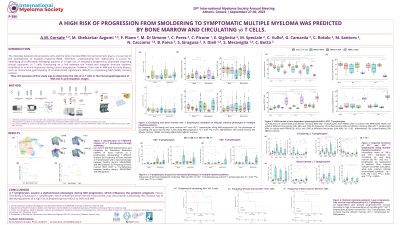Myeloma Microenvironment and immune profiling
Poster Session 3
P-386: A high risk of progression from smoldering to symptomatic multiple myeloma was predicted by bone marrow and circulating gamma delta T cells.
Friday, September 29, 2023
1:15 PM - 2:15 PM EEST


Anna Maria Corsale (she/her/hers)
PhD student
University of Palermo (Italy)
Palermo, Sicilia, Italy
Introduction: The interplay between clonal plasma cells and the bone marrow (BM) microenvironment plays a crucial role in the development of multiple myeloma (MM). Therefore, understanding this relationship is crucial for identifying and effectively managing patients at a high risk of neoplastic progression, ultimately improving clinical outcomes. γδ T cells, functioning as a link between innate and adaptive immune systems, contribute to immune responses during cancer progression. However, their role in MM and its early phases, such as monoclonal gammopathy of undetermined significance (MGUS) or smoldering MM (SMM), remains unclear. Thus, this study aimed to determine the role of γδ T cells in the immunopathogenesis of MM and its preneoplastic stages.
Methods: We conducted scRNAseq analysis on BM CD3+ cells from 3 healthy donors (HD), 5 MGUS/SMM patients, and 9 MM patients, analyzing a total of 12527 γδ T cells. Next, we performed flow cytometric analysis on 11 HD, 13 MGUS, and 29 MM patients to assess their frequency, differentiation/exhaustion profile, and effector functions. Finally, we functionally validated our results in vitro by co-culturing PBMCs or sorted γδ T cells from HD with MM cell lines.
Results: Through scRNAseq analysis, we identified 7 γδ T cell clusters: 2 naive subpopulations (CD4-/CD8- and CD4+), 3 GZMB effector/terminally differentiated subpopulations (CD8+/TIGIT+/LAG3+, TIM3+/CD27- and GNLY+/FTH1+) and 2 GZMK memory subpopulations (GZMK+ and CXCR3+). Moreover, as MM progressed, we observed a decrease in naive γδ T cells (p < 0.05) followed by an increase in TIM3 expression. No significant differences were observed in the frequencies of circulating and BM Vδ1+ and Vδ2+ T cells. However, effector memory Vδ2+ cells increased in MM patients compared to preneoplastic conditions and HD, where naive and central memory populations predominated (p < 0.05). Co-culture with the cell line U266 confirmed the expansion in effector memory Vδ2+ T cells (p < 0.01) and a decrease in central memory phenotype (p < 0.001), indicating an MM-dependent induced phenotypic alteration. Additionally, circulating and BM Vδ2+ T cells acquired an exhausted phenotype as MM progressed, mainly demonstrated by the co-expression of TIM3 and PD1 (p < 0.05). This altered phenotype was associated with impaired functions of Vδ1+ and Vδ2+ T cell subsets, as evidenced by reduced TNF-α and IFN-γ expression upon in vitro stimulation, along with overexpression of the CD69 molecule (p < 0.05). Notably, lower percentages of circulating and BM PD1+ Vδ2+, as well as BM effector memory Vδ2+ T cells (MGUS/SMM-like profile) were associated with improved patients' 1-year progression-free survival (p < 0.05).
Conclusions: BM γδ T cells acquire a dysfunctional phenotype during MM progression, which significantly impacts patient prognosis. Accordingly, circulating γδ T cells, which mimic the BM milieu, may serve as a potentially less invasive means for follow-up and prognostication of patients affected by monoclonal gammopathies.
Methods: We conducted scRNAseq analysis on BM CD3+ cells from 3 healthy donors (HD), 5 MGUS/SMM patients, and 9 MM patients, analyzing a total of 12527 γδ T cells. Next, we performed flow cytometric analysis on 11 HD, 13 MGUS, and 29 MM patients to assess their frequency, differentiation/exhaustion profile, and effector functions. Finally, we functionally validated our results in vitro by co-culturing PBMCs or sorted γδ T cells from HD with MM cell lines.
Results: Through scRNAseq analysis, we identified 7 γδ T cell clusters: 2 naive subpopulations (CD4-/CD8- and CD4+), 3 GZMB effector/terminally differentiated subpopulations (CD8+/TIGIT+/LAG3+, TIM3+/CD27- and GNLY+/FTH1+) and 2 GZMK memory subpopulations (GZMK+ and CXCR3+). Moreover, as MM progressed, we observed a decrease in naive γδ T cells (p < 0.05) followed by an increase in TIM3 expression. No significant differences were observed in the frequencies of circulating and BM Vδ1+ and Vδ2+ T cells. However, effector memory Vδ2+ cells increased in MM patients compared to preneoplastic conditions and HD, where naive and central memory populations predominated (p < 0.05). Co-culture with the cell line U266 confirmed the expansion in effector memory Vδ2+ T cells (p < 0.01) and a decrease in central memory phenotype (p < 0.001), indicating an MM-dependent induced phenotypic alteration. Additionally, circulating and BM Vδ2+ T cells acquired an exhausted phenotype as MM progressed, mainly demonstrated by the co-expression of TIM3 and PD1 (p < 0.05). This altered phenotype was associated with impaired functions of Vδ1+ and Vδ2+ T cell subsets, as evidenced by reduced TNF-α and IFN-γ expression upon in vitro stimulation, along with overexpression of the CD69 molecule (p < 0.05). Notably, lower percentages of circulating and BM PD1+ Vδ2+, as well as BM effector memory Vδ2+ T cells (MGUS/SMM-like profile) were associated with improved patients' 1-year progression-free survival (p < 0.05).
Conclusions: BM γδ T cells acquire a dysfunctional phenotype during MM progression, which significantly impacts patient prognosis. Accordingly, circulating γδ T cells, which mimic the BM milieu, may serve as a potentially less invasive means for follow-up and prognostication of patients affected by monoclonal gammopathies.
